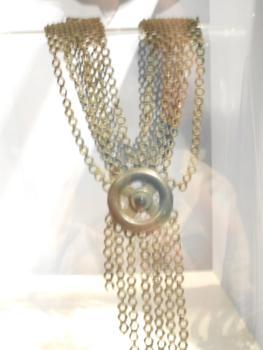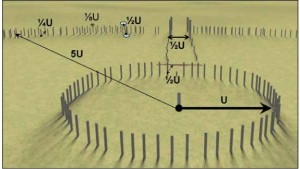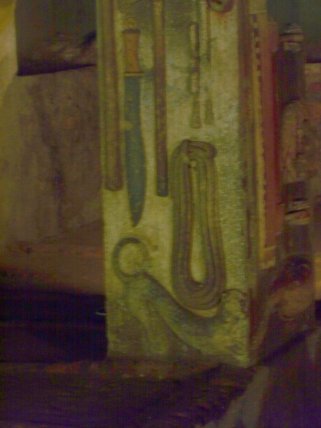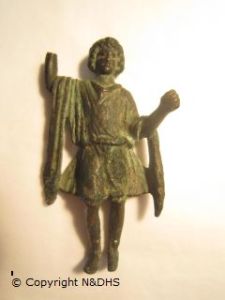In the current political atmosphere, there’s not a lot of focus on love, peace and understanding, so I’ve been keeping myself cheered up a bit by thinking about domestic and peaceful archaeology. This is a bit of an irony, of course, as my usual research oozes hairy chested, iron necklaced warrior machismo.

The use of the word ‘warriors’ applied to Iron Age Ireland is a bit too strong a word, maybe, but to quote Hot Fuzz, ‘ everyone’s packin’ round here.. Farmers… farmers’ mums…’ Two thousand years ago would certainly appear to be as bad as our own time, with too much snarling , jostling testosterone and not enough sensible ways to use that hormone. Seriously, could you imagine Cu Chullain doing something more practical than becoming the Incredible Hulk with all that eye bulging and fury? There’s sure-fire signs of the principle of comitatus, though, from the Togail Bruidne Dá Derga (likely a pretty tight recollection of hostilities in a pre-Christian Ireland, retold by medieval scribes), when poor old Conall Cernach ****SPOILER ALERT!!!!****** is questioned why he managed to survive the apocalyptic last battle. There are a few women who were scribbled into the pseudo-histories, Jungian archetypes such as Meabh, the ultimate Dame to Die For, where Frank Miller meets the Tain. There’s Macha Mong Ruadh, Scathach, and the Morrigan herself, all ambivalently supernatural, maybe a way to get round the idea of women living ( and occasionally dying) as equals in a boys own ‘hood, rare gangland godmothers on horseback. I like to imagine had they been into depicting humans back then, they’d have them all depicted as Red Sonja-esque bikini’d babes, about as realistic representations of women then as they are now, says she muttering cynically about battle porn. The Irish Iron Age as viewed by monks – boys will be boys and women lethal .
In the real world, however, found by cutting into mud and wattle some 2 or so millennia later, we discover very quickly that very few men or women were Irish versions of the Winter Soldier or Natasha Romanoff. I only know of one site which might – and I keep my fingers crossed on this one, as it’s currently part of my research – be a mass grave of that period (watch this space). The Iron Age blurs with either the end of the Bronze Age or the start of the Early Medieval period.
There’s scant detail of much except the enigmatic absence of agriculture, allowing land to be claimed by nature with scrubby woodland popping up around the place They call it the LateIron Age Lull, they say it’s exclusive to Ireland.. errr.. I’m not so sure about that! We have only scraped the surface of ordinary everyday life in Ireland 2000 years ago, with most of what we know relies on random finds of pretty shiny pointy things made of metal, and excavations of sites like Teamhair and Tlaghtga, meaning that we only get glimpses of the lifestyles of the rich and famous – the Uí Cairdasíans, and their feasts, sacrifices and dangerous tribal liasons. Needless to say, history takes that as a sign that it was all heroics, but hey – someone has to make the sandwiches and cut the grass. All that hero stuff takes a bit of infrastructure.

Where are the real, flesh and blood men and women of late prehistoric Ireland? Where are the families? We have the idea of relations being interred by the Early Medieval period in fertá –territorial ‘statement’ burial mounds such as the one made at the well of Clebach, when the princesses of Rathcroghan died shortly after their their conversion to Christianity by oul’ Paddy himself ( but you likely want to follow old foxy Vox Hiberionacum’s blog for more of that sort of thing). So – there were families. They couldn’t all be kings, princesses and demi-gods surely.
We have nothing like the intensely moving archaeology of domesticity like the remains of the Etruscan civilisation up in beautiful Tuscany. Wandering the tombs of Cerveteri, finding a stone bed made for corpses; it had stone pillows carved into it, with a painfully human touch – the indentation of an adult and a baby’s head scooped skilfully into the granite. It was as if they had just gotten up for night feeding, or to change nappies. I found I could not speak much for a while after that. Also in Cerveteri, the tomb painted as a home, with kitchen utensils painted on the walls, dogs and cats painted mooching for scraps of eternity, fresh fruits painted bright and ripe. It was a proper Italian kitchen, where the men were probably as frequently found as the women. Archaeology, why do you sometimes leave me with bloody great lumps in my throat?

I blame the shiny La Tene derivative things, although I love them deeply. They seduce you into a world of myths and sail you off to Manaanan’s land of faerie on the Broighter Boat. I can’t help wondering if we have even really, really, looked for the archaeology of peace and stability. Or have we just chucked all the peaceful stuff of pots and spindles into the Early Medieval, ‘cos, Christianity. I’ve a horrid suspicion this is what’s happened with the alleged lack of ceramics in the Irish Iron Age, but man, sherds are sods to date accurately. Apart from who you prayed to, I’m suspecting things didn’t change a lot for quite a while into the Early Medieval.
My Masters looked at the pollen and charcoal of Bohermeen Bog, which exists between Faughan Hill and Tlaghga, making it a seriously meaningful landscape. Years ago, close to the bog, a little lares figure was found, chucked in the water by some unknown hands until it washed up in a river somewhere between Jamestown and Navan , Co Meath.

Now, I’m not going to get into the why’s and wherefore’s of a Roman statue being found in Ireland… that’s for another day! But there is something quite poignant in that deposition, when I ruminate, as I do a lot.A lar was a wee household godling, who looked after families and brought prosperity – not far removed from the Robin Goodfellows, Piskies and Brownies of the British isles. Someone threw out the baby and the bathwater into that wetland, for unknown reasons, but once, this little piece of bronze belonged in a home. A nice, messy, chaotic home, although more likely a middle class one – dat Roman import, tho. A home far removed from the stuff like chariots (of which we have found little to no evidence yet) and war horns which have bewitched too many generations of researchers. And I guess I plead guilty ( or should that be gilty?) to that bewitchment initially too, until I really got into the research and started to see the real people and their livestock, instead of their artefacts of war.
Maybe our evidence will turn out to be as gossamer fine as wools they would have woven by firesides so long ago, needing the loom of research, and tedium to build the fabric of life up. The spindles and querns are obvious indications of daily life, but I like to think that the few human remains found, if proven to have lived to venerable ages, are evidence of nurture and food and family. We’re all here, as a population today so the Irish Iron Age, by sheer force of logic, could not have been all battle drums. We need to step over the harsh faced stone idols and pick up the wee lares figure, clean him up, give him a new cornucopia to hold and set him near our academic doorstep for luck.
More lovely, lovely reading….
O’Connor, R., 2013. The destruction of Da Derga’s Hostel: kingship and narrative artistry in a mediaeval Irish saga. Oxford: Oxford University Press.
Coyle McClung, L. 2013. The Late Iron Age lull – not so Late Iron Age after all!, Emania. 21. 73-83 Details of publication at : http://www.navan-research-group.org/emania.html
Sadowska, E. 1997. “Horses Led by a Mare” — martial aspects of Táin Bó Cúailnge, Emania. 16. 5-48. Details of publication at : http://www.navan-research-group.org/emania.html
Story of the lares figure available here: http://www.museum.ie/The-Collections/Documentation-Discoveries/September/A-Roman-figurine
Bieler, L (ed. and tr.). 1979. The Patrician texts in the Book of Armagh, Scriptores Latini Hiberniae 10. Dublin: Dublin Institute for Advanced Studies
Worthwhile blogs to mooch through…. irisharchaeology.ie and https://voxhiberionacum.wordpress.com
A wee bit more about the Late Iron Age Lull here: http://www.iqua.ie/Documents/newsletters/IQUA_newsletter_51.pdf
and here:
